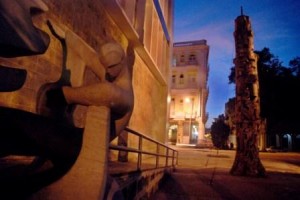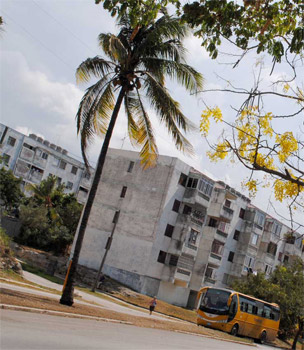Marisol, the Embargo and Coca Cola
Tourist Tales

Vicente Morin Aguado
HAVANA TIMES – I learned of Marisol through a friend, who notified me of her arrival. Days previous she had sent an e-mail containing a photo of herself and the following message: “This is me.”
In the airport we recognized each other at first sight. Of slight build, with her tanned skin highlighting her indigenous heritage, she was an architect by profession. This petite Oaxacan was about to change my routine regarding options for tourist excursions.
The next morning, emphasizing the architectural theme, I took Marisol to the scale size Havana model display. This is a miniature version of the city, including magnifying glasses that facilitate closer observation.
Without thinking twice, she looked through one of these and after only a few minutes fired off her first question: “Could you please tell me about that residential zone over there? Look, over there on the other side of the bay where there are a lot of identical buildings.”
I thought she was talking about East Havana, but her keen eyesight was focused beyond that, directly on the Alamar district. I, who had planned an easy day walking through the attractive alleys of the old city, had to board an “Almendron” (Big Almond), an old American car, disembarking together at a place that Havana residents consider very boring.
The construction of this working-class district dates back three decades, when the micro-brigades were created by order of the “Comandante”. These involved voluntary construction teams supplied on leave by each workplace, where workers made a commitment to build homes for their own families and for those who stayed behind to cover for them at work.
Dubious, the Mexican woman began the first of many rounds of questions, firing them in sequence like a dangerous machine gun: “I don’t understand – so there was something like underemployment in the country?” “It’s logical to think so,” I responded, “although the issue wasn’t really seen in that light.” “Fine, but what shocks me as an architect is this litany of buildings, all equally boring.”
“That’s true, since they were built by amateur builders.” “But wasn’t there a blueprint designed by professionals?” “Yes, there was one, my friend, but here there is often a large gap between what is said and what is done.”
“At any rate,” she added in an observation that hit the mark, “the work of the mail carriers must be very difficult in this twisting knot of streets.”

The course of the conversation became more complex when I spoke of the housing exchanges for Alamar, wherein the residents had to offer a substantial compensation, since it was an area on the periphery of the city with a low level of services in addition to the poor quality of the construction.
“Quality? Are there other problems aside from the aesthetic?” she asked.
“Yes, there are, and while we’re on the subject, could you clarify something for me? These buildings present serious leakage problems, above all on the decks. Is this normal for prefabricated structures?”
At that point, her expression became perplexed as she answered: “I don’t believe so. In Mexico this system is also used in the poorer districts, with the idea of lowering the costs and the time that it takes to finish the construction. But if you use adequate materials in the recommended quantities and without disregarding the proper methodology, there’s no problem. I can assure you from my own experience.”
Following such a complex conversation, whose direction could lead us right into the very philosophy of the State socialist system, the implacable Alamar sun prompted us to board another “Big Almond” for our return trip to the very touristy Old Havana.
Now things became easier for me, amidst stately mansions, churches and museums: a lot of photos, a great number of questions, but not so awkward for a Cuban’s first day with a foreigner.
Many days passed; the young Oaxacan woman went on to visit other provinces, returning one day prior to her departure. It was time to pay the bills, and I escorted her to a bank with the objective of getting the money out of her card. I’ll never forget that it was a BANAMEX.
Fifteen days previously, upon her arrival in Cuba, Marisol had taken out enough money for her daily expenses, leaving the fixed payments for the end, notably the rent for the house where she stayed amongst us. Now the bank’s reply nearly made her faint: the Banamex company had been absorbed into a United States consortium and had broken off relations with Cuba.
I attempted the best explanation I could muster to the owner of the house, as the Mexican offered up the only thing of value she had on her: a gold chain that was a family heirloom. The owner regarded us seriously and said: “Never mind, daughter, go home in peace. Maybe you won’t forget us. You know that among Cubans many emigrate, later drinking the “Coca Cola of forgetfulness.”
Eventually, the embassy of her country lent her a small sum to pay for the taxi and the airport tax. We said goodbye, reminding her of her positive experiences and reaffirming my trust in her honor.
I spent a few weeks avoiding the inquisitive looks of the rental owner until one day my e-mail “Inbox” displayed a bright blue underline on the address – “marisoloax.” The Oaxacan woman was writing from Arizona in the United States. She was soon to marry a Vietnamese, an immigrant like herself. They were doing well and she requested my personal information.
Days later I received the money through Western Union. I immediately went to the house of the woman whose property she had rented. In one hand I held the envelope so eagerly awaited by the property owner, and in the other an authentic can of Coca Cola.
Vicente Morín Aguado. [email protected]






The more I read the diary entries by the various writers at this website, the more and more I am convinced that I am getting honest reporting about an absolutely fascinating society. Wow!
. . . A delightful story with a happy ending. May future architectures employ creative imagination with their efficiency!